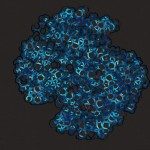Lien vers Pubmed [PMID] – 25740650
Nucleic Acids Res. 2015 Mar;43(6):3089-99
Signal transduction ATPases with numerous domains (STAND) get activated through inducer-dependent assembly into multimeric platforms. This switch relies on the conversion of their nucleotide-binding oligomerization domain (NOD) from a closed, ADP-bound form to an open, ATP-bound form. The NOD closed form is stabilized by contacts with the arm, a domain that connects the NOD to the inducer-binding domain called the sensor. How the inducer triggers NOD opening remains unclear. Here, I pinpointed the NOD-arm interface of the MalT STAND transcription factor, and I generated a MalT variant in which this interface can be covalently locked on demand, thereby trapping the NOD in the closed state. By characterizing this locked variant, I found that the inducer is recognized in two steps: it first binds to the sole sensor with low affinity, which then triggers the recruitment of the arm to form a high-affinity arm-sensor inducer-binding site. Strikingly, this high-affinity binding step was incompatible with arm-NOD contacts maintaining the NOD closed. Through this toggling between two mutually exclusive states reminiscent of a single-pole double-throw switch, the arm couples inducer binding to NOD opening, shown here to precede nucleotide exchange. This scenario likely holds for other STANDs like mammalian NLR innate immunity receptors.


